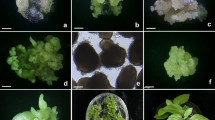Abstract
Calli were induced from 300,000 embryos isolated from immature to mature stage of seeds collected on late September from 14 elite trees. When the embryos were cultured onto plastic Petri-dish containing 20 mL of modified B5 basal medium supplemented with 3% (w/v) sucrose, 500 mg/L casein hydrolysate, 250 mg/L myo-inositol, 0.5% (w/v) polyvinyl polypyrrolidon (PVPP), 2×MS vitamins, 0.5 mg/L gibberellic acid, and 10 mg/L 2,4-D after 2 weeks of culture, yellowish-white calli were immediately formed on the surfaces of embryos, and subcultured for 4 weeks in same culture medium. Because most of calli maintained for more than 3 months were revealed differences in their colors, surface texture, and growth rate, visual selection was made for first round screening. When the size of visually selected calli larger than 19 mm in their diameter were inoculated, persistent proliferation was observed. Among the plating methods tested for the selection of rapid growing cell lines at single cell and/or small cell aggregate level, 2-layer spread plating revealed as the best for single cell cloning. To enhance cell growth and maintain high rate of viability for long-term culture of yew cells in bioreactor, final cell volume less than 50% in SCV seemed to be the best. Time course study revealed that 30% of inoculum density was suitable for fed batch culture. Among the tested conditional media, the rate of 1∶2 (old medium: fresh medium) was recorded at the best for cell growth.
Similar content being viewed by others
References
Slichenmyer, W. J. and D. D. Von Hoff (1991) Taxol: A new and effective anticancer drug.Anti-Cancer Drugs 2: 519–530.
Suffness, M. (1993) Taxo: From discovery to therapeutic use.Ann. Rep. Med. Chem. 28: 305–314.
Cragg, G. M., S. A. Schepartz, S. Suffness, and M. R. Grever (1993) The taxol supply crisis: New policies for handling the large-scale production of novel natural product anticancer and anti-hiv agents.J. Nat. Prod. 56: 1657–1668.
Joyce, C. (1993) Taxol: Search for a cancer drug.BioSci. 43: 133–136.
Borman, S. (1992) Taxol to be made from renewable materials by organic semisynthesis.C&EN. 12: 30–32.
Nicolaou, K. C., Z. Yang, J. J. Liu, H. Ueno, P. G. Nantermet, P. K. Guy, C. F. Clalborne, J. Renadud, E. A. Couladouros, K. Paulvannan, and E. J. Sorensen (1994) Total synthesis of taxol.Nature 367: 630–634.
Fett-Neto, A. G., S. J. Melason, S. A. Nicholson, J. J. Pennington, and F. DiCosmo (1994) Improved taxol yield by aromatic carboxylic acid and amino acid feeding to cell cultures ofTaxus cuspidata.Biotechnol. Bioeng. 44: 967–971.
Wickremesinhe, E. R. M. and R. N. Arteca (1994)Taxus cell suspension cultures: optimizing growth and production of taxol.J. Plant Physiol. 144: 183–188.
Ketchum, R. E. B., D. M. Gibson, and L. G. Gallo (1995) Media optimization for maximum biomass production in cell cultures of pacific yew.Plant Cell Tiss. Org. Cult. 42: 185–193.
Son S. H., S. M. Choi, S. R. Yun, O. W. Kwon, Y. H. Lee, and K. Y. Peak (1999) Large-scale culture of plant cell and tissue by biorector system.J. Plant Biotechnol. 1: 1–7.
Gamborg, O. L., R. A. Miller, and K. Ojima (1968) Nutrient requirements of suspension cultures of soybean root cells.Exp. Cell Res. 50: 148–151.
Rohr, R. (1973) Production de cals par les qametophytes males deTaxus baccata L. cultives sur un milieu artificied. Etude en microscopie photonique et electronique.Caryologia 25: 177–187.
David, A. and V. Plastira (1974) Histophysiologie ve getale. Realisation de cultures de tissue d’If (Taxus baccata L.) a partir de fragments de pousses a ges d’un an; obtention d’une culture indefinie.CR. Alad. Sci. Paris 279:1757–1759.
Gibson, D. M., R. E. B. Ketchum, N. C. Vance, and A. A. Christen (1993) Initiation and growth of cell lines ofTaxus brevifolia (Pacific yew).Plant Cell Rep. 12: 479–482.
Salandy, A., L. Grafton, M. R. Uddin, and M. I. Shafi (1993) Establishing on embryogenic cell suspension culture system in Florida yew (Taxus floridana).In Vitro Cell Dev. Bio. 29: 75.
Furmanowa, M., K. Gowniak, A. Zobel, J. Guzewska, G. Zgorka, L. Rapczewska, and A. Jozefezyk (1995) Taxol inTaxus baceata L. var.elegantissima organs and tissue culture.Med. Fac. Landbouw Univ. Genet. 60: 2115–2118.
Zhiri, A., M. Jaziri, J. Homes, M. Vanhaelen, and K. Shimomuria (1995) Establishment ofTaxus baccata callus cultures and evaluation of taxoid production.Med. Fac. Lanbouw. Univ. Genet. 60: 2111–2114.
Jaziri, M., A. Zhiri, Y. W. Guo, and J. P. Dupont (1996)Taxus sp. cell, tissue and organ cultures as alternative sources for taxoids production: a literature survey.Plant Cell Tiss. Org. Cult. 46: 59–75.
Park, Y. G., M. S. Choi, and S. H. Son (1996) XIXPopulus species (Poplars):In vitro culture and the production of anthocyanins.Biotechnology in agriculture and forestry 37: 319–334.
Lee, B. S. and S. H. Son (1995) A method for producing taxol and taxanes from embryo cultures ofTaxus species.Australia Patent No. 675147.
Wann, S. R. and W. R. Goldner (1994) Induction of somatic embryogenesis inTaxus, and the production of taxane-ring containing alkaloids thereform.WO Patent No. 93/19585.
Son, S. H. and R. B. Hall (1990) Plant regeneration capacity of callus derived from leaf, stem and root segments ofPopulus alba L.×P. grandidentata Michx.Plant Cell Rep. 9:344–347.
Park, Y. G. and S. H. Son (1992)In vitro shoot regeneration from leaf mesophyll protoplasts of hybrid poplar (Populus nigra × P. maximowiczii).Plant Cell Rep. 11: 2–6.
Kim, J. H., J. H. Yun, Y. S. Hwang, S. Y. Byun, and D. I. Kim (1995) Production of taxol and related taxanes inTaxus brevifolia cell cultures Effect of sugar.Biotechnol. Lett. 17:101–106.
Kim, D. I., S. Y. Byun, Y. S. Hwang, S. W. Kim, J. W. Kim, G. H. Lee, and S. Y. Lee (1994) Effect of inoculum density and basal media on cell growth and taxol production inTaxus cell suspension cultures.Current Biochem. Eng. 1: 109–112.
Author information
Authors and Affiliations
Corresponding author
Rights and permissions
About this article
Cite this article
Son, S.H., Choi, S.M., Choi, K.B. et al. Selection and proliferation of rapid growing cell lines from embryo derived cell cultures of yew tree (Taxus cuspidata Sieb. et Zucc). Biotechnol. Bioprocess Eng. 4, 112–118 (1999). https://doi.org/10.1007/BF02932380
Issue Date:
DOI: https://doi.org/10.1007/BF02932380




